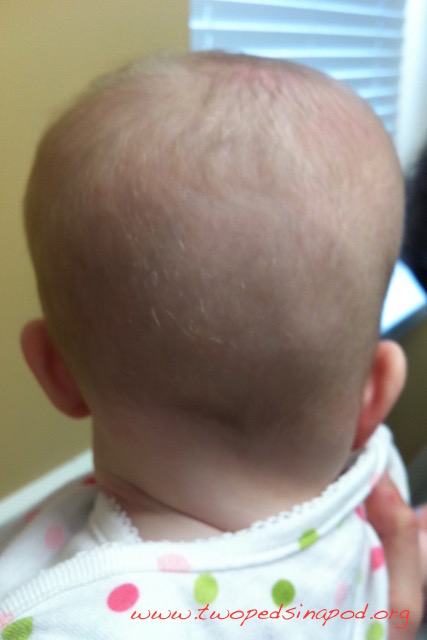 Squeezed through the birth canal, many babies are born with pointy, cone-shaped heads. Others, delivered by caesarian section, start off life with round heads. Few babies begin with a flat head. But as parents put babies on their backs to sleep in accordance with Sudden Infant Death Syndrome prevention guidelines, babies are developing flat heads.
Squeezed through the birth canal, many babies are born with pointy, cone-shaped heads. Others, delivered by caesarian section, start off life with round heads. Few babies begin with a flat head. But as parents put babies on their backs to sleep in accordance with Sudden Infant Death Syndrome prevention guidelines, babies are developing flat heads.
Called positional plagiocephaly, a young infant’s head flattens when prolonged pressure is placed on one spot. Tricks to prevent positional plagiocephaly all encourage equal pressure over the entire head. Because babies’ heads are malleable, parents can prevent and treat the flatness. In fact, the flat shape begins to correct itself as babies spend less time lying down and more time sitting and crawling. Additionally, increased hair growth hides some of the flatness.
To prevent positional plagiocephaly, place your baby prone (belly down) frequently WHILE AWAKE, starting in the newborn period. This tummy time decreases pressure on the back of the head. Some babies are not fond of tummy time and will cry until they are back on their backs. For those kids, check out our post on making tummy time more tolerable for your baby.
Encourage your baby to look to both sides while lying down. Too much time turned to one side will cause flattening on that side. Alternate how you place the baby in crib so that sometimes she turns to the right and other times she turns to the left to face into the room and away from the wall. If your baby seems to prefer looking only to the right or only to the left, place toys or bright objects toward the non-preferred side. If bottle feeding, switch off which arm you use to feed your baby, so that the baby sometimes turns to the right and sometimes to the left . If breastfeeding, start and end on the side that the baby tends to avoid. These actions will help prevent neck muscles from becoming too tight on one side and thus allow your baby to turn easily to both sides.
Some babies wear helmets to correct their abnormal head flattening. Neurosurgeons, who are head and brain specialists, and plastic surgeons prescribe these helmets for babies who have extreme flattening. Fortunately, the majority of babies with positional plagiocephaly do not need to wear helmets.
You also may have heard of babies who need corrective surgery for an abnormal head shape. This condition, called craniosynostosis, is rare. Pediatricians monitor the size and shape of the head , check the soft spot on the top of the head and for ridges on the skull at every check-up. A baby’s skull develops in pieces as a fetus, and these pieces eventually come together at predictable places called sutures. If the pieces come together too early or the soft spot closes too soon, corrective surgery may be needed.
So, avoid head flatness by rotating your baby’s position frequently (think rotisserie chicken!) and provide plenty of “tummy time” when awake. Start when the baby first comes home.
If you are worried about your baby’s head shape, just head on over to your baby’s pediatrician and bring up your concern. It is unlikely that your concern will “fall flat.”
Julie Kardos, MD and Naline Lai, MD
©2012, rev. 2016 Two Peds in a Pod®



